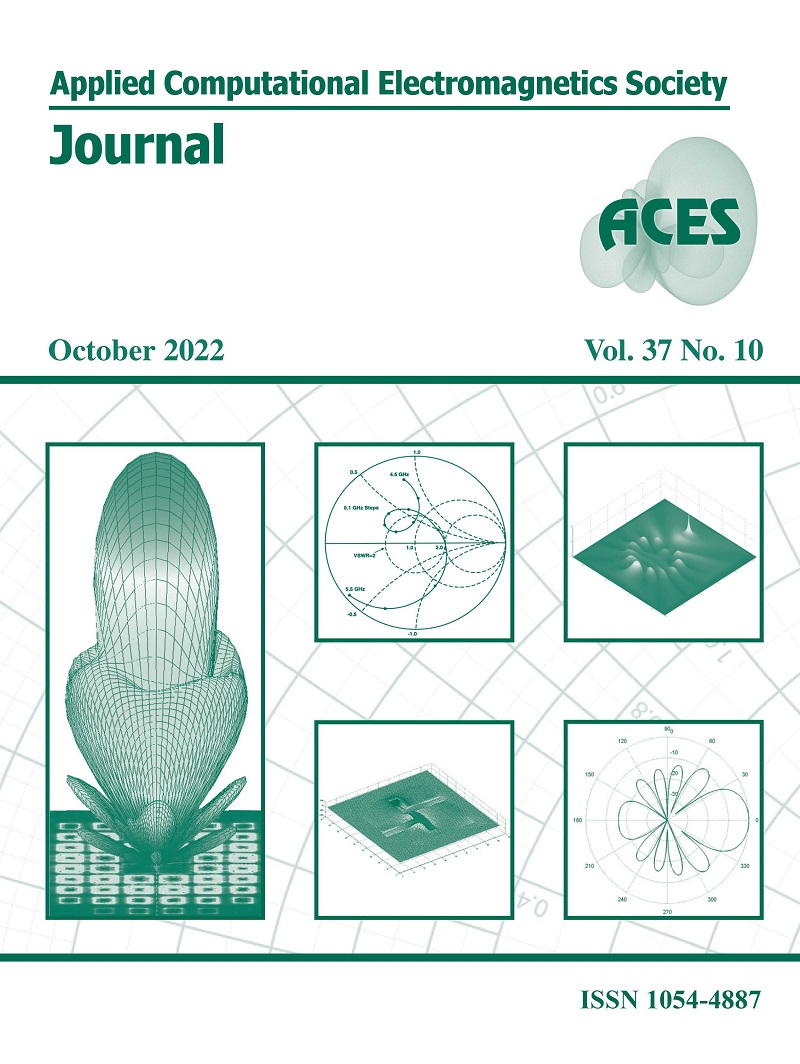Determination of the Physical Integrity of Ethernet Cables by Obtaining their Transmission Line Parameters from Measured Impedance Profiles
DOI:
https://doi.org/10.13052/2022.ACES.J.371005Keywords:
Ethernet cables, impedance profile, physical integrity, transmission line parametersAbstract
A method of determining the physical integrity of Ethernet cables by obtaining their transmission line parameters (resistance, inductance, capacitance, and conductance) from their measured impedance profiles are presented. The transmission line parameters were extracted across the cable lengths rather than frequencies used in most research. The method can be used to examine the physical integrity of Ethernet cables before their deployment. The study of the physical integrity of Ethernet cables is very important because, in typical installations, cables can be manipulated in the form of repeated coiling and uncoiling. The installation handling stress can adversely affect the signal integrity especially if they are substandard Ethernet cables. In this paper, four Ethernet cables were subjected to three coiling and uncoiling tests to represent installation handling stress. The impedance profiles of the four cables across their lengths were measured for the three handling stress test conducted. The computation of the transmission line parameters of the Ethernet cables using measured impedance profiles was implemented with the aid of Matrix Laboratory (MATLAB). The outcome of the research showed that the method presented will be very useful to cable installers and contractors in making objective decisions in the choice of cables for deployment.
Downloads
References
A. Oliviero, Cabling Part 1: LAN/Data Center Networks and Cabling Systems, 5th Edition. John Wiley and Sons Inc., 2014.
A. Semenov, “Design requirements to tel-telecommunications long ethernet twisted pair cable,” XIV International Scientific-Technical Conference on Actual Problems of Electronics Instrument Engineering (APEIE), Khartoum, pp. 27-31, Oct. 2018.
C. Spurgeon and J. Zimmerman, Ethernet: The Definitive Guide, Second Edition, O’Reilly Media, Inc, 2014.
R. Elton, E. Hamood, A. Mohammed, and A. Osman, “Early warning firefighting system using the internet of things,” International Conference on Computer, Control, Electrical and Electronic Engineering (ICCCEEE), Khartoum, pp. 111-118, Aug. 2018.
A. Gercikow, S. Schaffenroth, H. Schmidt, and A. Kolpin, “Measurement platform for physical-layer analysis of industrial and automotive ethernet,” IEEE Sensors Applications Symposium (SAS), Kuala Lumpur, pp. 122-128, Mar. 2020.
P. McLaughlin, “The past, present and future of cabling technologies, products and standards,” Cabling Installation and Maintenance Magazine, vol. 24, no. 12, pp. 27-29, Dec. 2018.
O. Ogundapo, C. Nche, “Modeling the insertion loss of structured ethernet cabling standard using the scattering parameters,” Applied Computational Electromagnetics Society (ACES) Journal, vol. 37, no. 4, pp. 435-440, Apr. 2022.
B. Shuman, “Is your Ethernet cable tough enough,” Cabling Installation and Maintenance Magazine, vol. 13, no. 9, pp. 25-27, Sep. 2003.
P. McLaughlin, “Counterfeit cable is getting ugly,” Cabling Installation and Maintenance Magazine, vol. 19, no. 8, pp. 31-32, Aug. 2011.
Beyondtech, “The three major counterfeit communications cabling scams,” Cabling Installation and Maintenance Magazine, vol. 21, no. 5, pp. 28-30, May 2017.
P. McLaughlin, “Copper clad aluminum conductors, the latest counterfeiting ploy,” Cabling Installation and Maintenance Magazine, vol. 19, no. 4, pp. 24-26, Apr. 2011.
FLUKE Networks, Copper Clad Aluminum Cables (CCA). 2019. Available online: https://www.flukenetworks.com/content/application-note-copper-clad-aluminum-cables accessed on Apr. 16, 2022.
M. Yamamura, Y. Kami, K. Murano, and F. Xiao, “Analysis of transmission line characteristics for twisted pair cables using the RLGC parameters of the cable,” Asia-Pacific Symposium on Electromagnetic Compatibility (APEMC), Taiwan, pp. 720-723, May 2015.
C. Afifah, C. Alam, F. Seman, A. Asrokin, and N. Nohan, “Impact of cable bleeding into RLGC of twisted pair copper cable and achievable rate,” 7th International Conference on Computer and Communication Engineering (ICCCE), Malaysia, pp. 321-326, Sep. 2018.
M. Degerstrom, B. Gilbert, and E. Daniel, “Accurate resistance, inductance, capacitance and capacitance (RLCG) from uniform transmission line measurements,” IEEE-EPEP Electrical Performance ofElectronic Packaging Conference, San Jose, pp. 77-80, Oct. 2008.
F. Ulaby, E. Michielssen, and U. Ravaioli, Fundamentals of Applied Electromagnetics, 6th Edition, Prentice Hall, 2010.
D. Pozar, Microwave Engineering, Fourth Edition, John Wiley and Sons Inc., 2012.
M. Sampath, “On Addressing the practical issues in the extraction of RLGC parameters for lossy multiconductor transmission lines using S-parameters models,” IEEE-EPEP Electrical Package, San Jose, pp. 259-262, Oct. 2008.
FLUKE Networks, “Datasheet: DSX-5000 cable analyzer.” 2019. Available online: https://www.flukenetworks.com/content/datasheet-dsx-5000-cableanalyzer accessed on April 15, 2022.
FLUKE Networks, “Versiv Cabling Certification Product Family User’s Manual, Versiv Software Version 4.8.” 2016. Available online: https://www.testequipmentdepot.com/fluke-networks/pdf/versiv_manual.pdf accessed on April 15, 2022.




